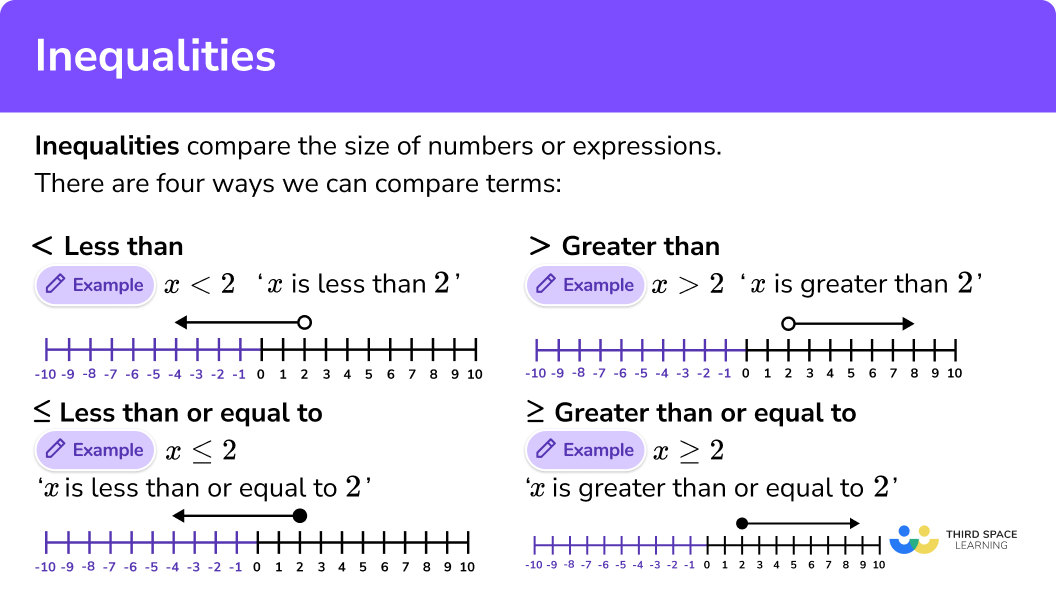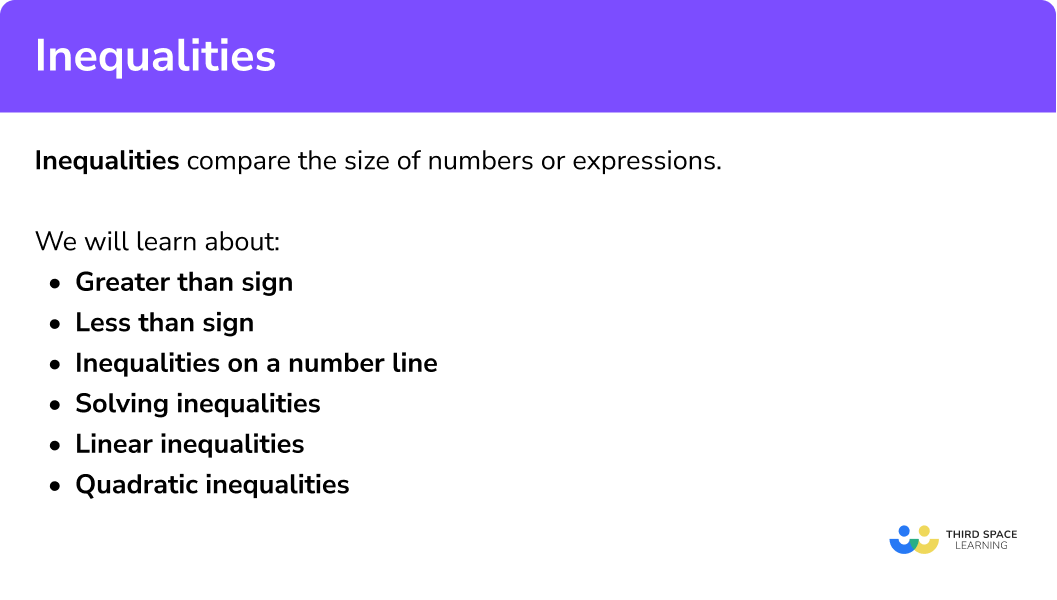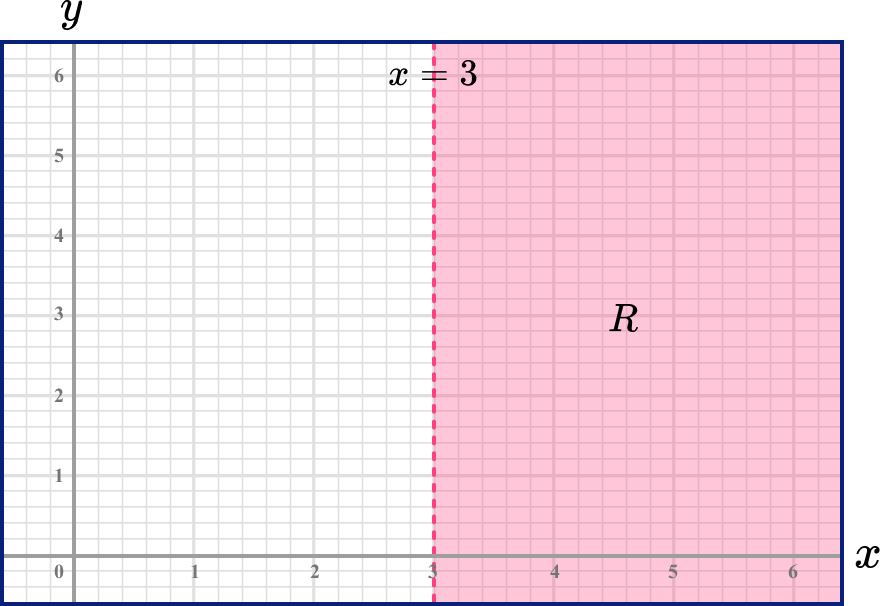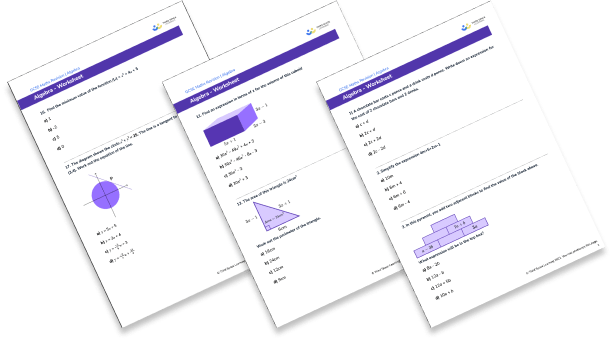GCSE Tutoring Programme
Our chosen students improved 1.19 of a grade on average - 0.45 more than those who didn't have the tutoring.
In order to access this I need to be confident with:
Algebraic expressions Solving linear equations Quadratic equations by factorising Quadratic formulaThis topic is relevant for:

Inequalities
Here we will learn about inequalities including how to represent inequalities on a number line, list integer values in solution sets, solve linear inequalities and solve quadratic inequalities.
There are also inequalities worksheets based on Edexcel, AQA and OCR exam questions, along with further guidance on where to go next if you’re still stuck.
What are inequalities?
Inequalities compare numbers or expressions in order of size.
There are four ways we can compare terms using inequality notation.
Less than
E.g.
x < 2‘ x is less than 2 ’
Step-by-step guide: Less than sign
Greater than
E.g.
x > 2‘ x is greater than 2 ’
Step-by-step guide: Greater than sign
Less than or equal to
E.g.
x \leq 2‘ x is less than or equal to 2 ’
Greater than or equal to
E.g.
x \geq 2‘ x is greater than or equal to 2 ’
What are inequalities?

Solving inequalities and solving equations
Inequalities are similar to linear equations but rather than there being one unique solution, there are many.
E.g.
Let’s solve this linear equation
The only solution is ‘ 5 ’.
However when the equals sign becomes an inequality sign there are many solutions.
Any value less than ‘ 5 ’ satisfies this inequality.
Solutions are real numbers that can be indicated on a number line and could be integers, fractions or decimals. They can also include positive numbers and negative numbers.
How to use inequalities
We can use inequalities in a variety of different ways including:
- Inequalities on a number line
- List integer values in a solution set
- Solving inequalities
- Quadratic inequalities
Let’s look at these in more detail below.
Explain how to use inequalities

Inequalities on a number line
An open circle shows the inequality does not include the value.
A closed circle shows the inequality does include the value.
E.g.
Represent x< 5 on a number line
x< 5 means ‘ x is less than 5 ’ so an open circle is placed at 5 .
x< 5 means that x can have any value less than 5 so an arrow is placed on the left hand side of the circle.
Step by step guide: Inequalities on a number line
List integer values in a solution set
We can list all of the integer values represented by an inequality
E.g.
List the integer values represented by 2 < x < 8
As ‘<’ means less than, the values of x do not include the values given.
‘ 2 ’ and ‘ 8 ’ are not included in the solution set.
So the integer values satisfied by the inequality are 3, 4, 5, 6, 7
E.g.
List the integer values represented by 2 \leq x \leq 8
As ‘ \leq ’ means less than or equal, the values of x do include the values given.
‘ 2 ’ and ‘ 8 ’ are included in the solution set.
So the integer values that form the solution set for the inequality are 2, 3, 4, 5, 6, 7, 8
Solving inequalities
Solving inequalities is where we calculate the values that an unknown variable can be in an inequality.
E.g.
Solve 4x + 2 < 14
Start by subtracting ‘ 2 ’ from both sides of the inequality
4x < 12Then divide both sides by 4
x < 3This means that x can take any value that is less than 3 .
Step by step guide: Solving inequalities
Linear inequalities
Linear inequalities are inequalities which only involve x with no higher powers. They are similar in style to linear equations.
For example, 3x+7>16
Step-by-step guide: Linear inequalities
Quadratic inequalities
Quadratic inequalities are similar to quadratic equations and when plotted they display a parabola. We can solve quadratic inequalities to give a range of solutions rather than up to two unique solutions.
E.g.
Solve x^{2} + 6x + 8 \leq 0
Let’s start by finding the roots of the quadratic expression by either factorising or using the quadratic formula.
Therefore the roots of the equation are -4 and -2 as these are the values of x that will make each bracket equal to zero.
We know that the roots are where the graph is equal to 0 (where it crosses the x axis) and the general shape is a ‘u’ shape (because the coefficient of the x^{2} term is positive).
So we can sketch the graph:
As the graph needs to be \leq 0 , we need values of x that will produce the graph that is below the x axis
-4\leq x \leq-2Step-by-step guide: Quadratic inequalities
Graphical inequalities
Representing inequalities on a number line can be extended into 2 dimensions. Graphical inequalities can also involve two variables.
E.g.
x>3The inequality x>3 can be represented on a x,y axes grid. There is a dashed line drawn at x=3 and the shaded region R is x>3.

You can find out more about graphical inequalities at:
Step-by-step guide: Inequalities on a graph

Inequalities worksheet

Get your free inequalities worksheet of 20+ questions and answers. Includes reasoning and applied questions.
DOWNLOAD FREE
Inequalities worksheet

Get your free inequalities worksheet of 20+ questions and answers. Includes reasoning and applied questions.
DOWNLOAD FREEInequalities examples
Example 1: representing inequalities on a number line
Represent x > 3 on the number line
- Indicate the values on the number line with an open circle or closed circle.
x > 3 means ‘ x is greater than 3 ’ so it is represented with an open circle.
2Indicate the values that are satisfied by the inequality with an arrow.
‘ x is greater than 3 ’ so an arrow is placed on the right hand side of the circle.
Example 2: representing inequalities on a number line
Represent -3<x \leq 6 on the number line
- Indicate the values on the number line with an open circle or closed circle.
‘ x is greater than -3 ’ so it is represented with an open circle.
x \leq 6‘ x is less than or equal to 6 ’ so it is represented with a closed circle.
2Indicate the values that are satisfied by the inequality with a line between the circles.
Example 3: listing integers that satisfy an inequality
List the integers that satisfy the inequality 1<x \leq 7
- Identify what the inequality signs indicate.
‘ 1 ’ is not included in the solution set as x is greater than 1 .
x \leq 7‘ 7 ’ is included in the solution set as x is less than or equal to 7 .
2List the integers that are satisfied by the inequality.
2, 3, 4, 5, 6, 7Example 4: solving linear inequalities
Solve 3x + 2 < 14
- Rearrange the inequality so that all the unknowns are on one side of the inequality sign.
2Rearrange the inequality by dividing by the x coefficient so that a single unknown is shown as an inequality with a value.
3Ensure you have the correct direction of the inequality sign.
The answer is x < 4 .
(Not ‘ 4 ’ or x = 4 )
Example 5: solving a quadratic inequality by factorising
Solve x^{2}+14 x+40 \leq 0
- Factorise the quadratic.
2Find the roots of the quadratic.
The values of x that make each bracket equal zero are x=-4 and x= -10
3Write the solution using interval notation.
-10 \leq x \leq -4Example 6: solving a quadratic inequality by using the quadratic formula
Solve 3x^{2}+4 x-5 < 0
- Identify values of a, b and c to substitute into the quadratic formula.
2Substitute the values into the quadratic formula.
x=\frac{-4 \pm \sqrt{4^{2}-4 \times 3 \times-5}}{2 \times 3}3Simplify to calculate the solutions of the inequality.
x=\frac{-4 \pm \sqrt{16--60}}{6} x=\frac{-4 \pm \sqrt{76}}{6}x = -2.12 and x = 0.786
4Use interval notation to represent the inequality.
We need 3x^{2}+4 x-5 < 0 , therefore we need the solutions between the two roots.
-2.12 < x < 0.7.86Common misconceptions
- Closed and open circles
A common error is to incorrectly identify if an open circle or closed circle is required by interpreting the inequality sign.
x < 4 would require an open circe
x\leq4 would require a closed circle
- Writing solutions as an inequality
When solving an inequality, a common error is to not include the inequality sign in the solution.
E.g.
x + 5 < 8The solution is x < 8 .
x = 8 or ‘ 8 ’ are not acceptable as it does not identify the range of values that satisfy the inequality.
Practice inequalities questions
1. Represent x \geq -2 on the number line.




x is greater than or equal to -2 so a closed circle is placed at ‘ -2 ’.
The values to the right hand side of the closed circle are indicated by an arrow as these values are greater than -2 .
2. Represent -4\leq x < 7 on the number line.




x is greater than or equal to -4 so a closed circle is placed at ‘ -4 ’.
x < 7x is less than 7 so an open circle is placed at ‘ 7 ’.
The values that satisfy the inequality are between these values and indicated with a line drawn between them.
3. List the integers that satisfy the inequality 3\leq x < 8




‘ 3 ’ is included in the solution set as the inequality sign indicates that x is greater than or equal to 3 .
x < 8‘ 8 ’ is not included in the solution set as the inequality sign indicates that x is less than 8 .
4. List the integer values that satisfy the inequality -5<2 x+1 \leq 3




Subtract one from all parts of the inequality.
-3 < x 1Divide all parts by 2 .
‘ -3 ’ is not included in the solution set as x is greater than -3 .
‘ 1 ’ is included in the solution set as x is less than or equal to 1 .
So the integer values satisfied by the solution set as -2, -1, 0, 1
5. Solve x^{2}-12x+27<0




Factorise the quadratic
(x – 9)(x – 3) < 0Find the roots by calculating which values of x make each bracket equal zero.
x = 9 and x = 3
We want the values of x that produce the curve below the x-axis
Write the solution using interval notation.
3 < x < 9
6. Solve 2x^{2}+6x-3<0




Identify the values of a, b and c from ax^{2} + bx + c
a = 2, b = 6, c = -3Substitute the values into the quadratic formula
x=\frac{-6 \pm \sqrt{6^{2}-4 \times 2 \times-3}}{2 \times 2}Simplify to find the roots
x=\frac{-6 \pm \sqrt{36–4}}{4} x=\frac{-6 \pm \sqrt{60}}{4}Write the solution using interval notation
-3.44 < x <0.44
Inequalities GCSE questions
1. (a) Write down the inequality represented on this numbers line
(b) List the integer values satisfied by the inequality in part a).
(3 marks)
(a)
Identifying -3 and 4
(1)
-3<x\leq4(1)
(b)
-2, -1, 0, 1, 2, 3, 4(1)
2. (a) Solve this inequality 5x – 1 < 19
(b) Represent your solution to part a) on the number line below
(4 marks)
(a)
Rearranging to 5x < 20 or identifying a solution of 4
(1)
x<4(1)
(b)
Indicates 4 , or their solution from part a) on the number line
(1)
(1)
3. (a) Solve the inequality x^{2}+x-12\leq 0
(b) List the integer values satisfied by the inequality in part a).
(5 marks)
(a)
Factorises the inequality to (x + 4)(x – 3)
(1)
Identifies solutions of ‘ -4 and 3
(1)
-4\leq x\leq 3(1)
(b)
Lists all but two correct integers
(1)
-4, -3, -2, -1, 0, 1, 2, 3(1)
Learning checklist
You have now learned how to:
-
Represent inequalities on a number line
-
List integers that satisfy an inequality
-
Solve linear inequalities
-
Solve quadratic inequalities
The next lessons are
Still stuck?
Prepare your KS4 students for maths GCSEs success with Third Space Learning. Weekly online one to one GCSE maths revision lessons delivered by expert maths tutors.

Find out more about our GCSE maths tuition programme.